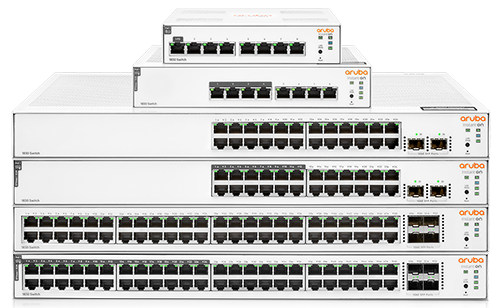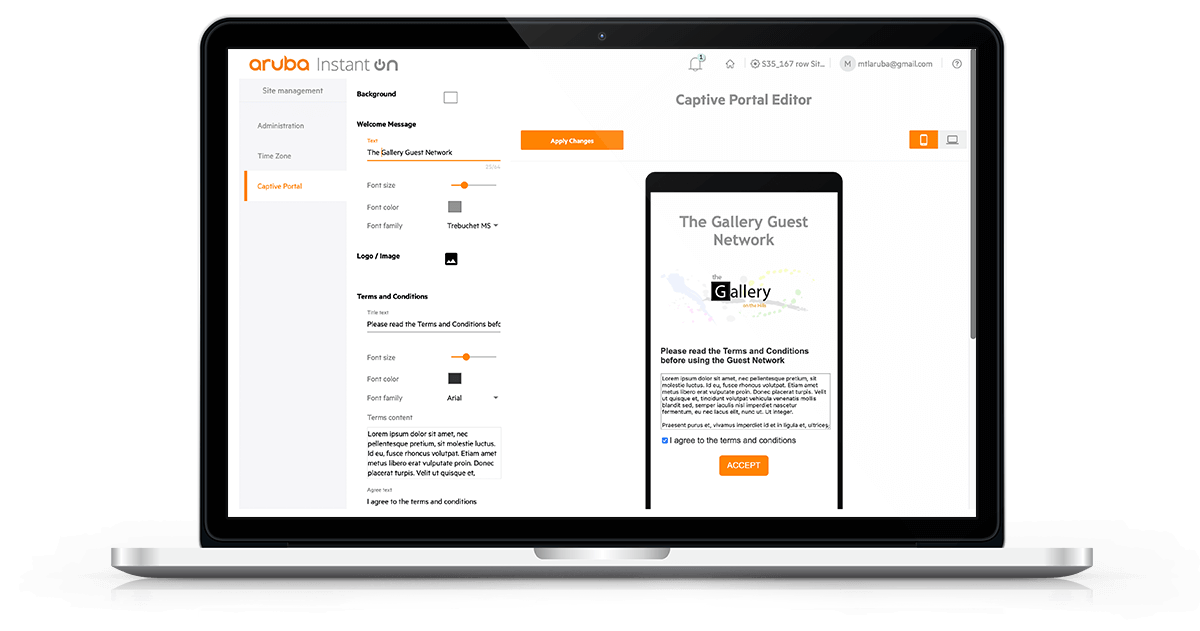Key Features
MANAGEMENT
Cloud-based management
The cloud-hosted web interface and mobile app make it easy to manage networks with Instant On APs and switches.
Simple local web GUI management
For management of individual switches, the intuitive Web GUI makes management simple, even for non-technical users. Supports up to five (5) HTTP and HTTP Secure (HTTPS) sessions.
Secure web-management sessions with HTTPS
Encrypts and otherwise protects management sessions through HTTP Secure (HTTPS), which prevents snooping of sensitive management information. Regardless of whether the switch is managed from the local Web GUI or the cloud, data between the switch and the management interface is encrypted and secure.
Firmware update
Provides notification of the latest firmware with the ability to schedule update at a preferred time through Instant On mobile app and cloud-based web portal.
Configuration File Management
Allows the user to back up and restore the configuration settings in case of a firmware upgrade or to apply them to other switches on the network.
DHCP client mode
Allows the switch to be directly connected to a network, enabling plug-and-play operation. In the absence of a DHCP server on the network, the switch falls back to the default static address 192.168.1.1.
Locator LED
Allows users to set the locator LED on a specific switch to either turn on, blink, or turn off; simplifying troubleshooting by making it easy to locate a particular switch within a rack of similar switches.
Comprehensive LED display
Provides an at-a-glance view of status, activity, speed, and fullduplex operation with per-port indicators.
Management VLAN ID
Provides secure management access to the switch for administrators from within the specified VLAN.
Simple Network Time Protocol (SNTP)
Allows automatic synchronization of the switch date and time for accurate tracking of system events and various schedules set by the administrator.
QUALITY OF SERVICE (QoS)
Class of Service (CoS)
Provides time-sensitive packets (like VoIP and video) with priority over other traffic based on DSCP or IEEE 802.1p classification; packets are mapped to four hardware queues for more effective throughput.
CONNECTIVITY
Auto MDI/MDI-X
Adjusts automatically for straight-through or crossover cables on all 10/100/1000 ports.
Auto-negotiating capability
Supports half/full-duplex auto-negotiating capability on every port that doubles the throughput of every port.
1G fiber connectivity
Provides 1G fiber connections for uplinks and other connections across longer distances than copper cabling can support. SFP ports are in addition to available copper Ethernet ports, providing a higher total number of available ports. Two (2) and four (4) SFP ports available on 24- and 48- port models respectively.
Ethernet Alliance PSE Class 4 PoE Certification
Power Over Ethernet (PoE) functionality is supported on certain 1830 models, known as power source equipment (PSE) ports which provide power to connected devices.
With half of the ports supporting Class 4 PoE, these models provide up to 30 W per port, which allows support of class 4 PoE or IEEE 802.3at capable devices such as video IP phones, wireless access points, as well as any 15.4 W IEEE 802.3af compliant end device, mitigating the cost of additional electrical cabling and circuits that would otherwise be necessary.
| Brand |
Standard |
Class |
Min. power at the PSE port |
Max. power consumed at the PD port |
Wire usage |
| PoE 1 |
IEEE 802.3 af |
0-3 |
15.4W |
13W |
2 pair |
| IEEE 802.3 at |
4 |
30W |
25.5W |
Ethernet Alliance PD Class 3 PoE Certification
Devices receiving power through PoE are referred to as powered devices (PDs).
The 8-port non-PoE Gigabit Ethernet model is a powered device that can be powered by an upstream Power over Ethernet (PoE) switch for environments where no line power is available, besides being powered up by an external power adapter. Port 1 supports Class 3 PoE with the capability of receiving IEEE 802.3af PoE power up to a maximum of 13W.
| Brand |
Standard |
Class |
Max. power consumed at the PD port |
Wire usage |
| PoE 1 |
IEEE 802.3 |
3 |
13W |
2 pair or 4 pair |
Auto-PoE power configuration
The switch automatically assigns the required power to a port for a PD device based on Link Layer Discovery Protocol (LLDP).
PoE power allocationSupport multiple methods (LLDP-MED automatic, class of PoE, or usage-based) to allocate PoE power for more efficient energy savings.
PoE Scheduling
Allows user to configure a specific day/time of the week (e.g., business hours) for Instant On switches to supply power to connected devices (e.g., surveillance cameras, access points etc.).
Port Scheduling
Allows user to configure up to three (3) schedules to enable or disable individual ports or PoE power delivery on certain switch ports by selecting a particular time of the day or a periodic occurrence.
SWITCHING
Flow control
Provides a flow-throttling mechanism propagated through the network to prevent packet loss at a congested node.
Spanning Tree Protocol (STP)
Supports 802.1D STP, 802.1w Rapid Spanning Tree Protocol (RSTP) for faster convergence. Provides redundant links while preventing network loops.
BPDU filtering
Drops BPDU packets when STP is enabled globally but disabled on a specific port.
Loop protection
Allows loop detection in the network for switches that do not run spanning tree, or on which STP feature is disabled.
IGMP v1, v2 snooping
IGMP snooping allows the switch to forward IPv4 multicast traffic intelligently. With IGMP snooping enabled, the switch forwards traffic only to ports that request the multicast traffic. This prevents the switch from broadcasting traffic to all ports and possibly affecting network performance.
Link aggregation
Groups together multiple ports of up to 16 trunks with a maximum of eight (8) ports per trunk automatically using Link Aggregation Control Protocol (LACP), or manually, to form a high-bandwidth connection to the network backbone that helps prevent traffic bottlenecks.
Link Layer Discovery Protocol (LLDP)
Advertises and receives management information from adjacent devices on a network, facilitating easy mapping by network management applications.
LLDP-MED (Media Endpoint Discovery)
Defines a standard extension of LLDP that stores values for parameters such as QoS and VLAN for automatic configuration of network devices such as IP phones.
VLAN support
Offers some of the benefits of both bridging and routing. VLANs partition the network into logical segments, which provide better administration, security, and multicast traffic management.
Port mirroring
Enables traffic on a port or VLAN to be simultaneously sent to a network analyzer for monitoring.
Auto recovery
Allows ports to be placed in a suspended state when defined error conditions are met. Features supported by Auto Recovery are BPDU Guard, Storm Control, Port Security, Loop Protection and Link Flap Prevention.
NETWORK SECURITY
TPM-based security
Includes a Trusted Platform Module (TPM) for secure hardwarebased generation and storage of cryptographic keys used for secure connection to the Instant On cloud portal.
Automatic denial-of-service protection
Manages high-volume traffic and prevents denial-of-service (DoS) attacks against the network.
Global Storm Control
Protects against conditions where incoming packets flood the LAN, causing network performance degradation for unicast traffic with an unknown destination, and for broadcast and multicast traffic.
PERFORMANCE AND EFFICIENCY
Energy Efficient Ethernet (EEE)
Compliant with 802.3az standard requirements to save energy during periods of low data activity.
Auto-port shut down
The switch saves power by automatically shutting down power to inactive ports. Power is restored on a port upon link detection.
Energy-efficient cooling
Includes variable speed fans operating only at the speed necessary to maintain operating temperature to reduce excess noise and power consumption.
Fan-less operation
Fan-less design for 8-port non-PoE, and PoE models as well as 24-port non-PoE model, making the switches ideal for silent operation environments.
FEATURES ACCESSED THROUGH LOCAL WEB-MANAGEMENT INTERFACE
Quick start-up wizard
Includes a quick start-up wizard which enable automatic configuring of the initial settings such as IP address, device information and system time.
Jumbo frame support
Supports up to 9216 bytes frame size to improve the performance of large data transfers.
User account management
Password strength checking and aging feature provides enhanced security to user account administration on the local web management interface. Password management further enhances the security so that only authorized users can access the switch’s web interface.
Secure Sockets Layer (SSL)
Encrypts all HTTP traffic and secures access to the local browser-based management of the switch.
SCP and TFTP file transfer
Provides different mechanisms for secure file transfer through SCP (Secure Copy Protocol) or TFTP.
Dual image support
Provide independent primary and secondary software images for backup while upgrading.
SNMPv1, v2c (read only)
Facilitates remote management of the switch as the device can be discovered and monitored from an SNMP management station.
DIAGNOSTICS
Event logs
Provides detailed information for problem identification and resolution.
Session logging
Displays the active users connected to the switch, displaying client IP address, duration of the individual session.
Remote syslog
Provides support for a single syslog server allowing the user to redirect and store events to a remote syslog server (supported on local web only).
Cable diagnostic tool
Provides the mechanism to detect and report potential cabling issues, such as cable opens or cable shorts on copper links, in addition to providing distance to the fault and total length of cable (supported on local web only).
Ping IPv4
The switch supports ICMP for sending ping requests to IPv4 addresses.
Support file
Includes summary information for the switch including the current switch configuration, statistics and buffered log messages (supported on local web only).
MAC address table
Also known as the bridge table or the forwarding database, this table enables the switch to forward traffic through the appropriate port and supports up to 16K MAC address entries.
WARRANTY, SERVICE AND SUPPORT
Aruba Instant On Limited Lifetime Support provides 24X7 phone support for the first 90 days and chat support for the entire warranty period. Community support is included for the life of the product.








